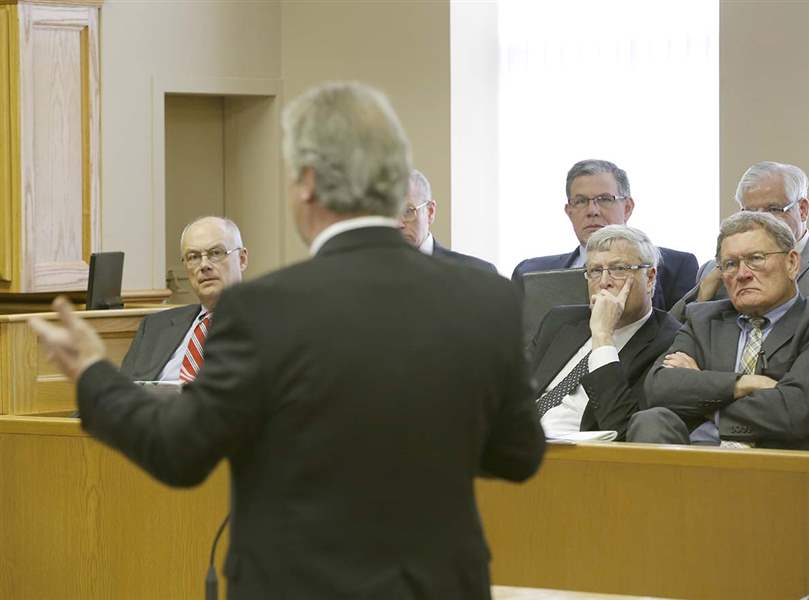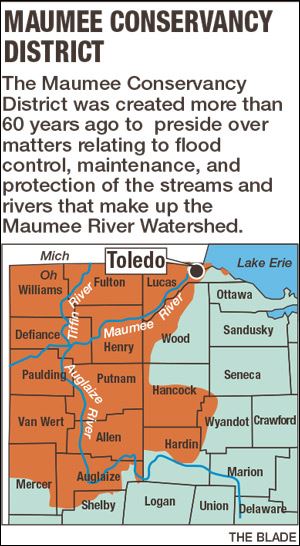
IN SESSION
Judges keep annual court date to tend to area watershed
5/7/2014
Front row, from left, Wood County Judge Reeve Kelsey, Auglaize County Judge Frederick D. Pepple, and Allen County Judge David Cheney. Back row, from left: Lucas County Judge Gene Zmuda and Hancock County Joseph Niemeyer listen to district manager Lynn Army’s presentation in Defiance.
THE BLADE/JETTA FRASER
Buy This Image

Front row, from left, Wood County Judge Reeve Kelsey, Auglaize County Judge Frederick D. Pepple, and Allen County Judge David Cheney. Back row, from left: Lucas County Judge Gene Zmuda and Hancock County Joseph Niemeyer listen to district manager Lynn Army’s presentation in Defiance.
DEFIANCE — When court was called to order, not one but 14 common pleas judges filed into the courtroom.
Two joined Defiance County Common Pleas Judge Joseph Schmenk on the bench, while the other 11 took seats in the jury box. One was absent.
A most unusual panel — the Maumee Watershed Conservancy Court — was in session for another year to preside over matters relating to flood control, maintenance, and protection of the streams and rivers that make up the Maumee River Watershed.
Made up of one judge from each of the 15 affected northwest Ohio counties, the court, whose origins date back to 1947, likely will be the entity that oversees a massive flood-control project proposed for the Blanchard River in Hancock and Putnam counties. A flood in 2007 caused some $60 million in damages in the city of Findlay and $20 million in damages in the village of Ottawa.
It was clear at last week’s court session, typically a once-a-year event, that the project is a top priority.
“What’s our current status with the Blanchard River?” Putnam County Judge Randall Basinger asked before the presentation had even begun.
Mike Pniewski, project manager for the U.S. Army Corps of Engineers, told the judges that the Corps hoped to complete its feasibility study by November, 2015, and present the plan to Congress for approval and funding in 2016.

The agency received $1.5 million in federal funding in April, he said, which combined with a local share of $1.35 million, will allow it to complete the study.
Lucas County Judge Gene Zmuda asked how big a factor cost would play in the project’s design.
Mr. Pniewski said he couldn’t say but noted that construction costs are estimated between $125 million and $200 million.
The conservancy court has made no decisions regarding the Blanchard project and for now is being kept apprised by the Corps of Engineers, a point Judge Schmenk stressed.
“At this point this entity has nothing in the project,” he said. “It’s obviously significant because it’s a major occurrence within the watershed, but it’s not our project.”
Lynn Army, manager of the conservancy district, said the court potentially would become the “local sponsor” of the project — a role now filled by Hancock County commissioners — when the study is completed. At that point, the court would oversee construction of the project and levy assessments if necessary on property owners who stand to benefit from it.
Former Hancock County Engineer Steve Wilson said Ohio formed its first conservancy district in Dayton after a devastating flood hit the city in 1913. Local leaders went to the state legislature with a plan to form an entity that could oversee improvements to the Miami River.
Mr. Wilson said it was agreed that judges were best suited for the job.
“They didn’t want it to be political,” he said. “They tried to make it as apolitical as possible.”
“When you go to court, you present the facts and make a decision based on the facts,” he said. “It does seem odd having 15 judges in charge of something like this.”
Judge Basinger, who has been a part of the conservancy court for 25 years, said afterward that the Blanchard River project easily would be the conservancy district’s largest project ever, and, yes, he is eager to see it happen.
“It’s a problem that needs to be solved for both Findlay and Ottawa,” he said.
Contact Jennifer Feehan at: jfeehan@theblade.com or 419-213-2134.